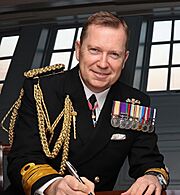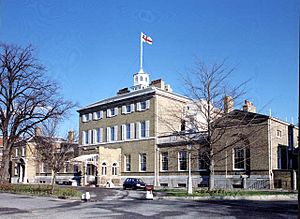Second Sea Lord facts for kids
Quick facts for kids Office of the Second Sea Lord and Deputy Chief of the Naval Staff |
|
|---|---|

Ensign of the Royal Navy
|
|
| Ministry of Defence | |
| Abbreviation | 2SL/DCNS |
| Member of | Admiralty Board Navy Board |
| Reports to | First Sea Lord |
| Nominator | Secretary of State for Defence |
| Appointer | Prime Minister
Subject to formal approval by the King-in-Council
|
| Term length | Not fixed (typically 4–5 years) |
| Inaugural holder | Rear Admiral George Dundas |
| Formation | Second Naval Lord, 1830–1904 Second Sea Lord from 1904 |
The Second Sea Lord and Deputy Chief of the Naval Staff is a very important job in the Royal Navy. This person is the second highest-ranking officer. They work closely with the First Sea Lord, who is the top officer.
The main responsibilities of the Second Sea Lord are looking after the people (personnel) in the Royal Navy. They also manage the Navy's bases and buildings on land. This role has changed names a few times over the years. It started as the Second Naval Lord in 1830. Then, in 1904, it became the Second Sea Lord. Today, the office is based at Navy Command Headquarters.
Contents
- History of the Second Sea Lord Role
- Second Naval Lords, 1830–1904
- Second Sea Lords and Commanders-in-Chief Naval Home Command, 1995–2012
- Second Sea Lords and Chiefs of Naval Personnel and Training, 2012–2015
- Second Sea Lord and Deputy Chief of the Naval Staff, 2015–present
- Departments that Work with the Second Sea Lord
- See also
History of the Second Sea Lord Role
Back in 1805, the Royal Navy started giving specific jobs to its senior officers. The Second Naval Lord became the second most important officer on the Board of Admiralty. This person was in charge of all matters related to the Navy's personnel. This meant they handled everything about the sailors and officers. In 1917, the title officially changed to Second Sea Lord.
In 1994, after the Cold War ended, the British Armed Forces made some changes. The job of Second Sea Lord was combined with another important role. This was the Commander-in-Chief, Naval Home Command. This new combined role helped make the Navy more efficient. The Commander-in-Chief, Naval Home Command, was created in 1969. It brought together the leaders of the Portsmouth and Plymouth naval bases.
Headquarters and Flagship Changes
Today, the Second Sea Lord works in Portsmouth. Their office is on Whale Island. For many years, until October 2012, the Second Sea Lord had a special honor. They flew their flag from HMS Victory. This is the world's oldest warship still in active service. It is kept in a dry dock in Portsmouth. This tradition came from the Commander-in-Chief, Naval Home Command.
However, in 2012, new changes were made to the Navy's leadership. The special "Commander-in-Chief" roles were stopped. Now, the First Sea Lord has full command responsibility. The First Sea Lord now flies their flag from HMS Victory.
In 2016, the role was updated again. It became the Second Sea Lord & Deputy Chief of the Naval Staff. This new title clearly shows their responsibilities. They are in charge of making sure the Naval Service has the right people. They also ensure the Navy has the correct equipment and buildings for today and the future.
This is a list of some of the important officers who held this role when it was called the Second Naval Lord:
- Rear Admiral George Dundas, 1830–1834
- Vice-Admiral Sir William Parker, 1834
- Vice-Admiral Sir John Beresford, 1835–1841
- Vice-Admiral Sir William Parker, 1835–1841
- Rear Admiral Sir Edward Troubridge, 1841
- Vice-Admiral Sir William Gage, 1841–1846
- Vice-Admiral Sir James Dundas, 1846–1847
- Vice-Admiral Sir Henry Prescott, 1847
- Vice-Admiral Sir Maurice Berkeley, 1847–1852
- Vice-Admiral Sir Houston Stewart, 1852
- Vice-Admiral Sir Phipps Hornby, 1852–1853
- Vice-Admiral Sir Maurice Berkeley, 1853–1854
- Vice-Admiral Sir Richard Dundas, 1854–1855
- Vice-Admiral Henry Eden, 1855–1857
- Vice-Admiral Sir Richard Dundas, 1857
- Vice-Admiral Henry Eden, 1857–1858
- Vice-Admiral Sir Richard Dundas, 1858–1859
- Rear Admiral Frederick Pelham, 1859–1861
- Vice-Admiral Sir Charles Eden, 1861–1866
- Vice-Admiral Sir Sydney Dacres, 1866–1868
- Vice-Admiral Sir John Tarleton, 1872–1874
- Vice-Admiral Sir Geoffrey Hornby, 1874–1877
- Vice-Admiral Sir Arthur Hood 1877–1879
- Admiral Richard Meade, 1879–1880
- Admiral Lord John Hay, 1880–1883
- Admiral Beauchamp Seymour, 1883–1885
- Admiral Sir Anthony Hoskins, 1885–1888
- Vice-Admiral Sir Vesey Hamilton, 1888–1889
- Admiral Sir Henry Fairfax, 1889–1892
- Admiral Sir Frederick Richards, 1892–1893
- Admiral Lord Walter Kerr, 1893–1895
- Vice-Admiral Sir Frederick Bedford, 1895–1899
- Admiral Lord Walter Kerr, 1899
- Vice-Admiral Archibald Douglas, 1899–1902
- Admiral Sir John Fisher, 1902–1903
Here are some of the officers who held the combined role of Second Sea Lord and Commander-in-Chief Naval Home Command:
| Rank | Name | Image | In office |
|---|---|---|---|
| Vice Admiral | Sir Charles Montgomery |  |
2012 (and see above) |
| Vice Admiral | Sir David Steel |  |
2012–2015 |
This is the current title for the role. You can find more details at Deputy Chief of the Naval Staff.
Departments that Work with the Second Sea Lord
The Second Sea Lord oversees several departments. These departments help manage the Navy's people, training, and future plans.
Current Departments
- Director People and Training: This department handles all matters related to Navy personnel and their training.
- Director Development: This group focuses on developing the Navy's future abilities and equipment.
- Office of the Assistant Chief (Policy): This office helps create the Navy's rules and plans.
- Office of the Director of Personnel and Training & Office of the Naval Secretary: These offices work together on personnel and training matters.
- Director Navy Acquisition: This department is in charge of getting new equipment and ships for the Navy.
Former Departments
Over time, some departments have changed or been combined. Historically, the Second Sea Lord's office worked with many different groups. These included those dealing with medical services, education, and recruiting for the Royal Navy and Royal Marines.
See also
- First Sea Lord
- Third Sea Lord
- Fourth Sea Lord
- Fifth Sea Lord











